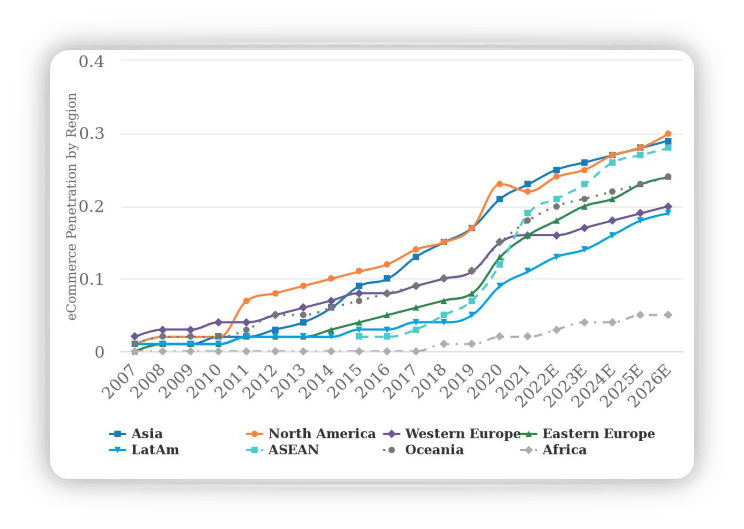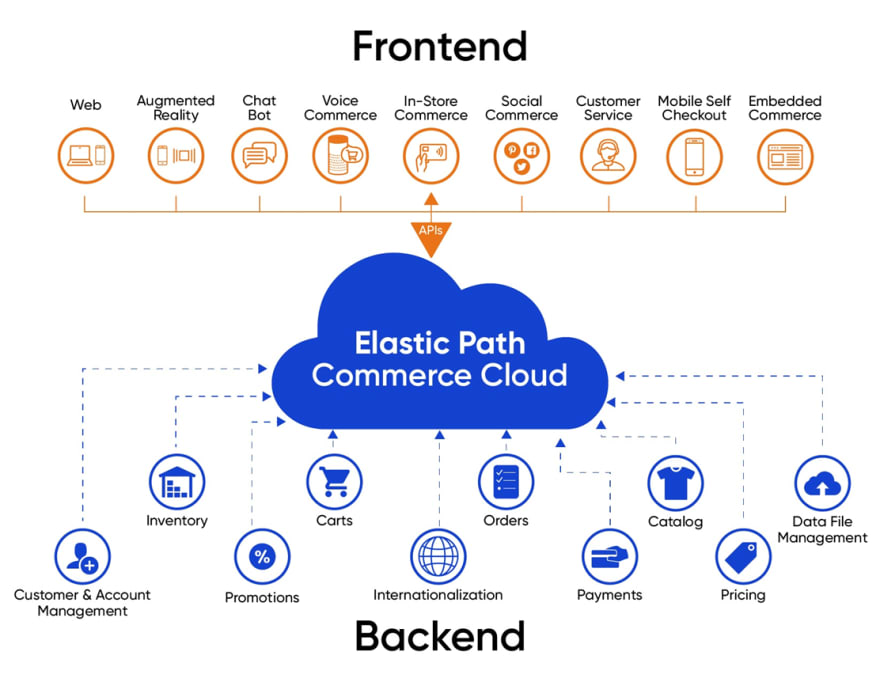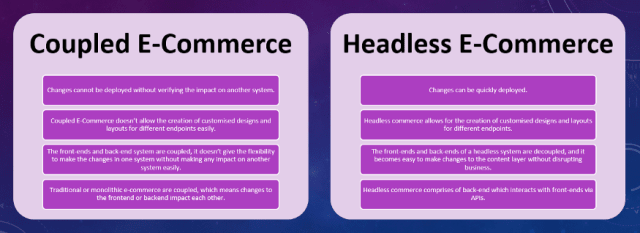WHY E-COMMERCE GROWTH CAN STAY STRONGER FOR LONGER
An article “Global E-Commerce Growth Forecast 2022” by Morgan Stanley says:
- In the initial days of COVID-19 e-commerce business surged and very soon it was picked up as all the shopping was done Online as retail locations were closed due to the virus spread.
- Overall retail sales in 2019 were 19% and it was picked up to 21% in the year 2021. It is roughly estimated that 22% of sales would be in 2022.
- It further states that even after COVID e-commerce market will grow in long term and could see a spike from $3.3 trillion today to $5.4 trillion in 2026.
- User purchase behaviour has changed over this period and it’s contributing to the growth and marketplace expansion.
E-commerce as a percentage of retail sales continues to grow across regions.

Source: Euromonitor, National Data Sources, Morgan Stanley Research estimates
WHAT IS HEADLESS COMMERCE?
Now that we know how the e-Commerce market is going to grow over a period of time, it’s time to discuss Headless Commerce.
Headless commerce is an e-commerce architecture which decouples the front end from the backend. In other words, it decouples the customer-facing front-end application of eCommerce from the backend system’s commerce functions and business logic.

Source: ElasticPath
WHAT ARE THE BENEFITS OF HEADLESS COMMERCE?
- It is less error-prone since the front-end and back-end are decoupled.
- It will eventually help in causing less impact on each other and changes can be deployed smoothly.
- It helps in updating or editing front-end and back-end systems.
COUPLED E-COMMERCE VS HEADLESS E-COMMERCE

HEADLESS COMMERCE PROVIDERS
- Adobe Commerce (formerly Magento Commerce)
- Shopify Plus
- BigCommerce Enterprise
- CommerceTools
- Elastic Path
- Salesforce Commerce Cloud
- SAP
- OroCommerce Enterprise
- Spryker
- Swell
- SpreeCommerce
- Saleor
HEADLESS COMMERCE NEEDS EXTENSIVE LEVELS OF TESTING FOR A BETTER CUSTOMER EXPERIENCE
Headless Commerce communicate or interact with many systems at various level of technology and it requires extensive levels of testing which can cover all aspect.
Some of these layers include:
- Component Level Testing
- Application Programming Interfaces (APIs) Testing
- Integration Testing
- Database Testing
- User interfaces (UI) or presentation layer.
Typically testing can start from the Component level and APIs can be tested for each of these components. Reflect of data can be tested on UI, for example, if a payload value is changed how it reflects on the front-end if the content is changed from CMS then how it reflects on the front-end.
Covering all the aspects of the application can be challenging and requires an extensive amount of planning and execution to incorporate the rapid changes throughout the software life cycle.


Top comments (2)
Really enjoyed your breakdown of headless commerce! The way you explained how decoupling the front-end and back-end can lead to smoother deployments and better scalability was super insightful. It's clear that as e-commerce continues to grow – projected to reach $5.4 trillion by 2026 – adopting flexible architectures like headless commerce will be crucial for staying competitive.
Quick question: For smaller businesses looking to transition to a headless setup, what would you recommend as a first step?
Looking forward to more of your posts!
Thank you for your comprehensive analysis on e-commerce growth and headless commerce. Your paper successfully emphasises the dramatic shift in consumer behaviour during the early stages of the COVID-19 epidemic, when internet buying increased owing to the closure of retail sites. The numbers you presented, which show an increase in overall retail sales from 19% in 2019 to 21% in 2021 and an expected 22% in 2022, highlight the growing trend of e-commerce.
Your description of headless commerce, in which the front-end is separated from the back-end, provides useful information about how this design allows for greater flexibility and less error-prone changes. The advantages you mentioned, such as speedier deployments and the option to upgrade or alter front-end and back-end systems separately, are quite appealing. To delve deeper into the benefits of our ecommerce growth and discover why it's the perfect solution for you, click this link to access more information.